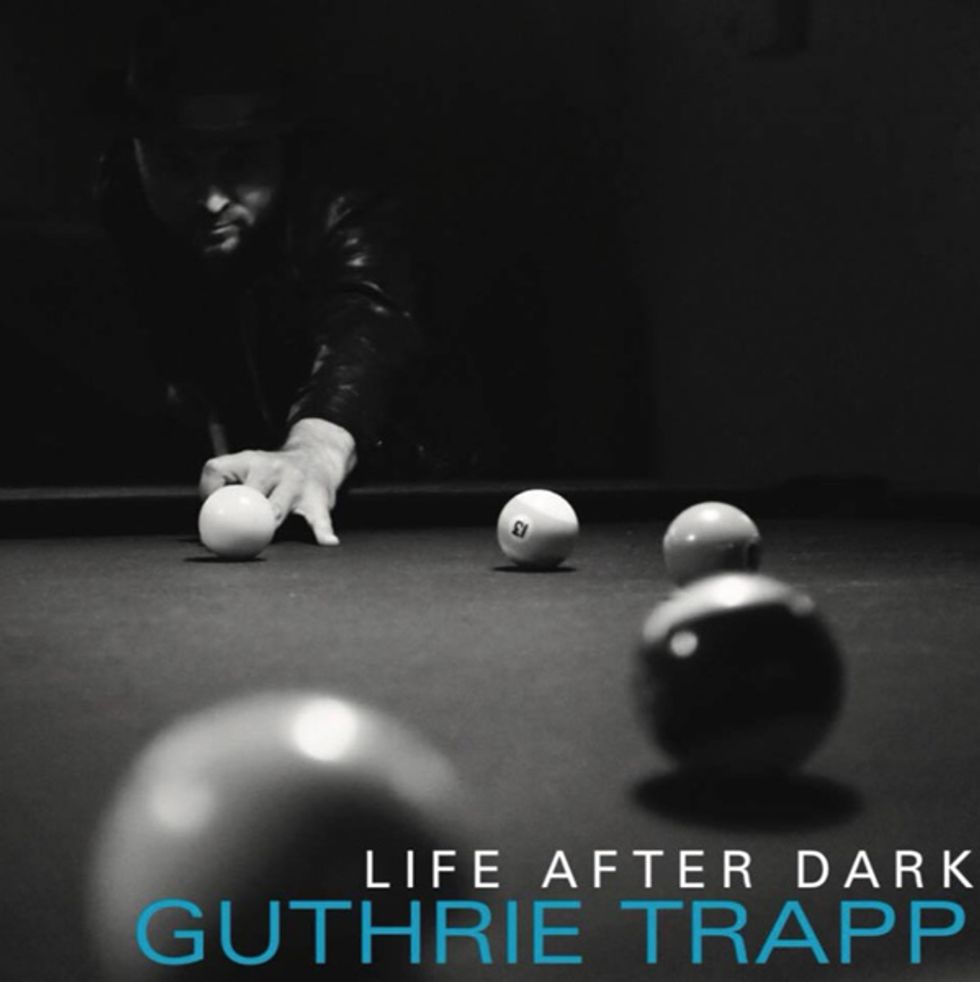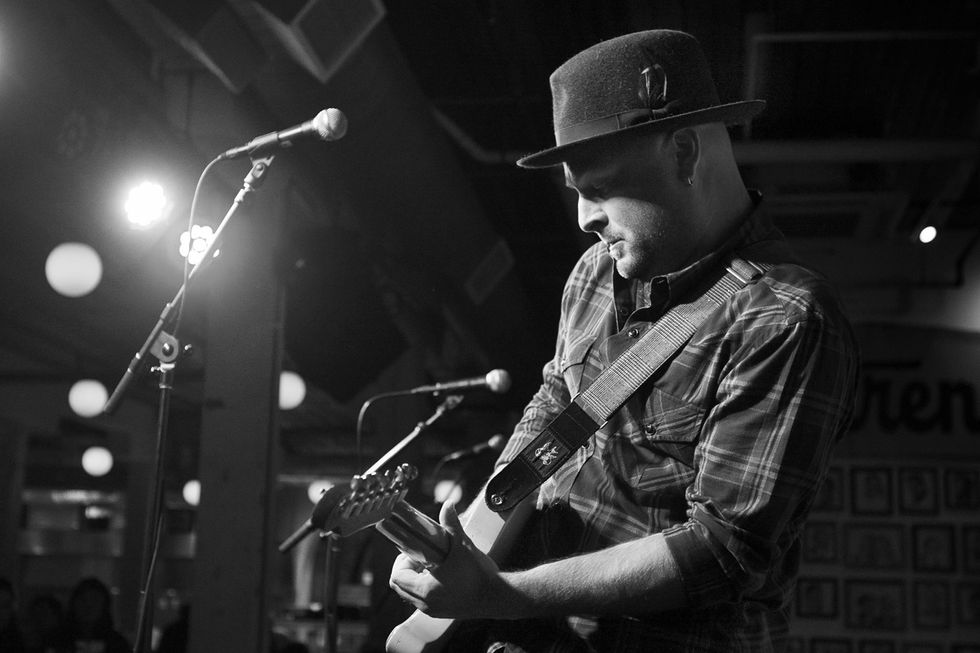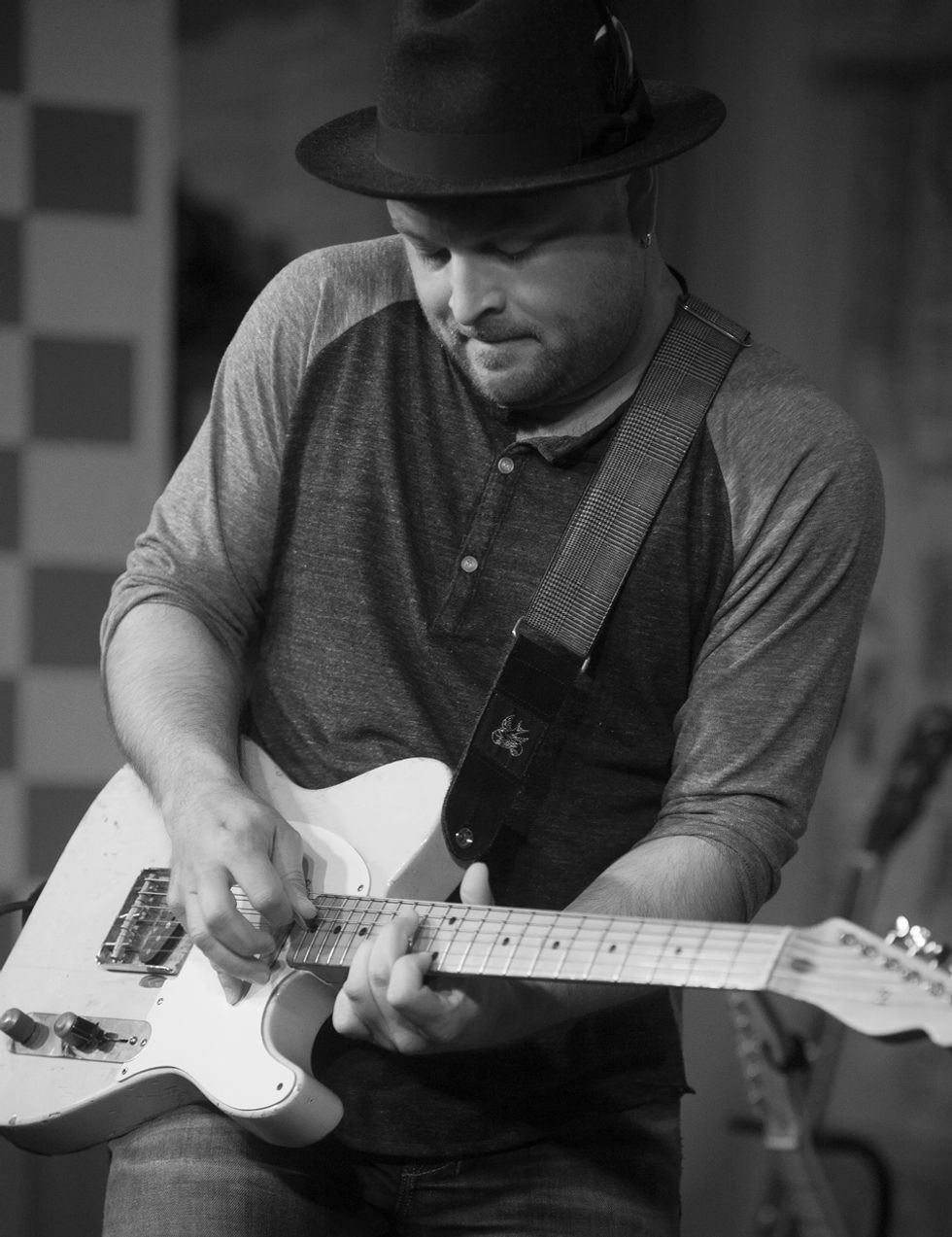Robert’s Western World is one of the hole-in-the-wall clubs along Nashville’s lower Broadway adult playground. The place smells like the cheap hamburgers and cheaper beer it dispenses, but to hard-core country music lovers, it sounds like nirvana. It’s the one joint where old-school country music prevails, and the electric guitar is always king.
At Robert’s, the king’s chamberlain is Don Kelley, whose band holds court—for more than 20 years now—Wednesdays through Saturdays. Kelley’s a dynamic singer and a good picker, but like John Mayall, he’s got an ear for great pickers. And in the realm of Nashville guitar, the Don Kelley Band has become the equivalent of Mayall’s Bluesbreakers, offering an apprenticeship to a litany of monster players before unleashing them on the world. Heavyweight graduates of Kelley’s academy of twang include Brent Mason, J.D. Simo, Redd Volkaert, Daniel Donato, and Johnny Hiland.
And Guthrie Trapp. Trapp is Nashville’s current Man of a Thousand Gigs. He can be found holding down residencies at places like Broadway’s Acme Seed & Feed and Dee’s Country Cocktail Lounge, the new hipster enclave in nearby Madison, Tennessee, or playing jazz-informed instrumentals onstage at the live-broadcast Music City Roots, or playing sessions for tradition-informed country albums, filling in on Broadway (sometimes with Kelley), or giving guitar lessons on YouTube and ArtistWorks.com. His fluid execution of rapid-fire country licks and blues bends, mixed with Latin montuno and dabs of Wes Montgomery and Jeff Beck, all filtered through articulate, edge-of-breakup tone, has forged a style thousands are viewing and hundreds are flocking to learn.
In his 30s, Trapp is firmly established as a recording and touring musician. Although his timeline in Nashville roughly coincides with the rise of Bro-country, he has carved out a career that steers clear of overtly commercial Music Row fare. Instead, his resume includes work with a Who’s Who of American music heroes: Alison Krauss, Ashley Monroe, George Jones, Roseanne Cash, Luther Dickinson, Earl Scruggs, Delbert McClinton, Emmylou Harris, Jerry Douglas, and Rodney Crowell, to name but a few.
The latest addition to his resume is Life After Dark, Trapp’s second album—an eclectic collection of tunes that features some of the friends he’s made since coming to Nashville in 2001. There’s the grinding “New Walkin’ Blues” (featuring Jeff Beck vocalist Jimmy Hall), a classic-sounding country weeper with Vince Gill on vocals, and a simmering take on Blind Willie Johnson’s “Nobody’s Fault But Mine” with a powerful chorus of Danny Flowers, Bekka Bramlett, and the McCrary Sisters. Mandolin giant Sam Bush, Dave Matthews Band saxist Jeff Coffin, and singer-songwriter Charlie Worsham also get their licks in on the album. But the licks mostly come from Trapp, whose instrumental “Shag Rug Burn” is a soul-guitar ripper and whose “Commodity” displays his tone at its most elegant and eloquent.
Bay Seasoning
Trapp was raised in Lillian, Alabama, on the Florida-Alabama line where Perdido Bay joins the Gulf of Mexico, separating those states. “I didn’t grow up on Top 40, the Beatles, or Led Zeppelin,” Trapp relates. “My mom, dad, and most of my family are old hippies who listen to folk, bluegrass, singer-songwriters, and some jazz. If it was rock, it was folk-rock like Van Morrison, Bob Dylan, and Jackson Browne. Being around that music as a kid, my ear developed even before I picked up an instrument.

TIDBIT: Trapp used four small vintage Fender amps on his new Life After Dark, but his main amp for the sessions was a Bogner Goldfinger 54 Phi running into an open-back 2x12 cabinet.
“My uncle was a self-taught musician,” he continues. “I’m an only child and he was the closest thing I had to an older brother. At around 8 or 9, I’d pick up a guitar and start noodling around when his band would take breaks at a rehearsal.”
By his tween years, Trapp was taking the guitar seriously. His was a pre-YouTube generation, raised on albums and video lessons. “I was watching tapes of [bluegrass guitar virtuoso] Tony Rice and dropping the needle on Allman Brothers, Lynyrd Skynyrd, Johnny Winter, and New Grass Revival records,” says Trapp. “I was playing a lot of bluegrass, but at the same time I would jam on electric guitar, learning how to overdrive an amp. I’d go in my uncle’s music room, turn up as loud as I could without driving everybody nuts, and wail away. I learned lead lines and pentatonic blues before I learned any chords. I learned how to play by ear. I still don’t know how to read music. I can read a Nashville numbers chart, but that’s about it.”
A lack of formal music education didn’t hamper his opportunities to play. By the time Trapp was 12, he was good enough on mandolin and guitar for a local bluegrass band to hire him. His earn-while-you-learn experience began with a constant stream of four-hour gigs on Pensacola Beach, where he put in his 10,000 hours playing the many bars that dot the coast. While still in his teens, he began playing electric guitar with a band called the Filthy Rich. “We played original music, old blues, jazz, and some Western swing at all the parties and gigs on the Gulf Coast, seven nights a week, and twice on Sunday. I was making good money,” he recalls.
Trapp might still be playing those bars if not for meeting Nashville-based songwriter Gove Scrivenor. “I started playing mandolin and acoustic guitar with him at the Flora-Bama bar, where the Frank Brown International Songwriters Festival is held,” he recalls. “After the bar closed at 3:30 a.m., we’d go to the owner’s beach house next door. Hank Cochran and Lefty Frizzell albums would play until 8 in the morning. Mickey Newbury was there one night, drinking tequila out of a pint bottle, smoking a cigarette, with his nose hooked up to an oxygen tank. Those fellas were hard-core. That’s where I learned how to play with songwriters. They would put the fear of God in you. You didn’t play on top of their vocals or you were done.”
Though Scrivenor and others encouraged him to move to Nashville, Trapp put it off, believing everybody had to be as good as Brent Mason to make a living. Eventually, a need to escape the endless beach party life led Trapp to relocate—at first commuting back to the Gulf Coast in order to earn enough to pay for an apartment on Music Row.
While he’s a superb utility player backing up other musicians, Trapp’s electric style really comes to the fore on his own gigs where his fusion of country, rock, bluegrass, jazz, and Latin sounds distills into an original voice. Here, he’s at Nashville’s Acme Seed & Feed. Photo by Steve Harman
Broadway or the Highway
For a hot country guitar picker in Nashville looking to get noticed, all roads lead to Robert’s Western World and the Don Kelley Band. “My local music store in Nashville had been playing their CD,” says Trapp. “I said, ‘Who’s that guy playing all those steel bends?’ They said, ‘That’s Johnny Hiland. He plays with Don down at Robert’s.’ I went down to Broadway every night they were playing and stood in the doorway. Within a month or so I knew Don well enough to say, ‘If Johnny can’t make the gig, I’d love to sub for him.’ But he wouldn’t let me play until one night this guy who knew him said, ‘You should let Guthrie sit in.’ Don let me get up a few times and finally said, ‘Johnny’s leaving next year. If you want the gig you can have it.’ I played that gig for four years, four nights a week, four hours a night.
“Don would tell me what pickup to use on which songs, and would say things like, ‘If you’re playing a country shuffle, play the first solo on the front pickup, and the second solo on the back pickup.’ Playing those songs at those tempos and being the only soloist meant my chops were probably at their best for that style of music while I was in that band.”
A year or so into his Robert’s tenure, Trapp landed a gig with country star Patty Loveless. “All the stuff that I learned with Don translated to her gig,” he says. Between Loveless and Kelley, Trapp no longer had to commute to the Gulf Coast to earn his rent. Through his 20s he toured with Loveless and resonator virtuoso Jerry Douglas. “The bluegrass I had been working on translated to the Jerry Douglas gig,” he says.
Trapp’s steady rise has been based on massive musicality, fed by prodigious technical skill that encompasses rapid bluegrass-style flatpicking mixed with the classic Nashville hybrid pick-and-fingers style. “All the alternate picking stuff from bluegrass helped with electric guitar,” he says. “The hybrid picking didn’t come in until I started playing electric. I got turned on to Danny Gatton and started learning from videos.
“I’ve practiced my ass off,” says Trapp. “I never practiced with a metronome, but I learned by playing along to records, and then from performing live. Most young kids are not jamming at parties and festivals or playing club gigs for 10 or 15 years. They don’t have the time, opportunity, or patience.”

Guitars
Floyd Cassista T-style with Fender Mexico Tele pickups
Russ Pahl T-style with Pahl handwound pickups: S-type pickup in the neck and T-type in the bridge
Russ Pahl T-style with Pahl handwound pickups: Firebird-type in the neck and T-type in the bridge
Danocaster Double Cut
1969 Gibson ES-335
Gretsch G6118T-LTV 125th Anniversary
Collings 290
Jerry Jones Baritone SingleCut
LSL Topanga with P-90s
Floyd Cassista S-type with Lindy Fralin pickups
Two vintage Teiscos
National M2 resonator
Sim Daley Mandolin
Nylon string acoustic (maker unknown)
1933 Gibson L-00
1955 Gibson J-50
Collings 000
Early-1970s Fender Precision bass
Amps
1966 Fender Princeton Reverb with Eminence Private Jack
1966 Fender Deluxe Reverb with Eminence Alessandro GA-SC64
1966 Fender Vibrolux Reverb with Celestion G10s
1966 Fender Pro Reverb with Eminence Alessandro GA-SC64s
Bogner Goldfinger 54 Phi
Magic Amplification Brit MkII
Vox AC15 Hand-Wired
Effects
J. Rockett GTO
Vintage Nobels ODR-1
John Landgraff Dynamic Overdrive
XAct Tone Solutions Precision Multi-Drive
Custom fuzz by Barry O’Neal of XAct Tone Solutions
Xotic RC booster
Strymon Brigadier delay
Strymon El Capistan delay
Strymon Flint Tremolo & Reverb
Electro-Harmonix Deluxe Memory Man
Vox Wah
Gretsch Play Boy
T-Rex Tremster
Moog Moogerfooger MF-102 Ring Modulator
MXR Phase 90
Boss DD-7 Digital Delay
Boss TU-2 Tuner
Dunlop DVP1
Dunlop DVP3 Volume (X)
Strings and Picks
Fender-style medium picks (played using the round edge)
Glass slides (medium to heavy)
D’Addario (.010–.046)
D’Addario Baritone Light Gauge EXL158 (.013–.062)
D’Addario ECG25 Flatwound Light (.012–.052, for Teisco)
D’Addario EJ40 (.011–.047, for acoustic guitar)
D’Addario EJ74 (.011–.040, for mandolin)
In a town where many session players are required to record tracks over drum machines for an endless string of “artists” singing virtually identical lyrics about the girl, the beer, the truck, and the lake, Trapp has managed to make a living while avoiding those kinds of sessions. He contends it is not really a choice.
“You end up where you’re supposed to be,” he explains. “If I chased pop country music to make money, I would be unhappy because I would be playing music I don’t like, and I wouldn’t be good at it because I don’t like it.”
Guthrie U
Thankfully, Trapp is able to find alternate income streams in a number of successful, music-related, side projects. One is a teaching career that includes working with the giant online educational company ArtistWorks.
“I didn’t get into education on purpose, but the more I played live, the more people wanted to take lessons,” says Trapp. “I thought, ‘If I can teach and make a little extra money, why not promote it a bit?’ I put a couple of things up on social media and started teaching some private lessons. I found I enjoy it and it can be lucrative, so I started doing more.
“ArtistWorks approached me because I can teach the country-guitar curriculum, and they appreciated that I was active on social media and would be good about promoting it. They helped me develop a curriculum. I would send them some drafts and we’d go back and forth for a couple of months until we got it mapped out. We filmed about 300 lessons: beginner, intermediate, and advanced, with five cameras and high-quality audio. I’ve got about 550 or 600 students all over the world now. Once you subscribe to the lessons, you have the option of doing a video exchange. For example, somebody in Australia can send me a video of his or her progress, and I can respond with another video. I’m seeing a ton of progress with these students.”
Trapp is involved with another educational venture, Segue 61, which is a kind of graduate school for people entering the music industry. It covers all the things you need to know after you have learned your craft. “A couple of guys approached me about getting involved in creating a post-graduate, boutique, mentor-driven, eight-month, certificate-based program here in Nashville,” Trapp explains. “I provide them with mentors and teach classes. We bring in Nashville working professionals to teach publishing, branding, artist development, engineering, producing, songwriting, management, tour management, and law. Everybody has to take all the workshops. Even if you are a songwriter, you have to take everything else, so you can communicate in the professional music world.”
A third project is a signature pedal deal with J. Rockett Audio Designs: the GTO (Guthrie Trapp overdrive). “They wanted to do a pedal with somebody in Nashville, but not necessarily a Keith Urban or Brad Paisley,” he says. “We came up with an overdrive based on one of my favorite old pedals—the Nobels ODR-1, which is a Nashville staple. The original Nobels was like a Tube Screamer without all that midrange. It was a smooth overdrive that didn’t change your tone. It just sounds like you’re cranking up an amp. My version has a bit more gain, more tone control, and is better built than the Nobels.”
Trapp’s first solo album, 2016’s Pick Peace, integrated all his influences into a mature, fully realized style over 10 instrumentals. His new Life After Dark seems more like the kind of album many session guitarists release first: a calling card that displays a mastery of many genres—blues, country, African, and jazz—on individual tracks. It also enlists the sort of cadre of guest stars guitarists often feature on their debut releases.
“For the first record, I didn’t want people to think I was relying on their names to try to sell it,” says Trapp. “I wanted vocal guests on this one, just because I love playing with singers. We had some of my favorites. Jimmy Hall is like a Southern Mick Jagger. Jeff Beck, who could have anybody in the world sing with him, uses Jimmy because he’s a badass. I also wanted to have some of my instrumental heroes, like [mandolinist] Sam Bush, but I didn’t want guitar guests. I never understood why a guitar player would make a record and then have 10 guest guitarists. Vince Gill sang on the record but didn’t play guitar. He said, ‘You’ve got that covered.’”
“All the alternate picking stuff from bluegrass helped with electric guitar,” Trapp says. “The hybrid picking didn’t come in until I started playing electric. I got turned on to Danny Gatton and started learning from videos.” Photo by Steve Harman
Known as a master of the Telecaster, Trapp has played a T-style instrument by local luthier Floyd Cassista since his Don Kelley days. “My Floyd needed a refret, but after the refret it got weird, so I didn’t play it very much on this record,” he says. “I played a Tele-style parts-caster with Ron Ellis pickups that I don’t have anymore. It had an enormous neck, which is part of the reason it sounded good. Now I’ve got a couple of Russ Pahl Teles, which are awesome.
“All the slide was on my Teisco. With big flatwound strings tuned to open D, it’s automatically pretty nasty sounding. It’s got four pickups and a vibrato arm. I found this Ry Cooder-ish out-of-phase tone on it. There are little selector buttons, but you’ve got to be careful because if you bump the switches they will move in the middle of a song. I think it did that on ‘I’m So Lonesome I Could Cry.’”
Trapp’s sound tends toward warm and clean. It’s an unforgiving tone that, in the hands of a lesser player, would easily reveal any sloppiness. “I want the notes to be articulate, probably because I didn’t grow up playing rock,” he explains. “I’m usually a blackface Fender guy and I used a few on this record, but mostly I used a Bogner Goldfinger 54 Phi amp. There are two 6L6s and two 6V6s that you can use separately or combine for different power settings, from 9 to 66 watts. It has a 2x12 open back cabinet. It’s a small head with a sweet top end and a great reverb. I hate playing through a dry amp. I’ll always use reverb and delay as I’m tracking. I used the Strymon El Capistan tape-type delay a lot, although lately I’ve been using their Brigadier. It’s more present, not so dark.”
Although he rarely plays acoustic live with his own band, his adeptness on that instrument is also displayed on Life After Dark. “I played my 1955 Gibson J-50 on ‘Crossing the Bridge,’” says Trapp. “On ‘Leiper’s Fork,’ I played the J-50 along with a Collings OM and my Sim Daley mandolin. Daley used to work for Gibson, and then started building his own mandolins. I’ve had that one since probably 2005.”
The sleep until noon, drug taking, rock-star guitarist is largely a thing of the past. Making a living as a musician in the 21st century requires diversification and hard work. With James Brown departed, Guthrie Trapp may have inherited the mantle of “hardest working man in show business.” There is the session work, the video lessons, the music school, promoting the pedal, and his steady Facebook and Instagram posts. And we haven’t even mentioned his “Trapped Above Ground” radio show (currently on hiatus) on Acme Radio, the internet broadcast affiliate of the Broadway club where he’s got a weekly gig. And that’s when he’s not touring with John Oates—a relatively recent addition to his list of notable employers.
Trapp epitomizes the modern 6-string hero: technically spectacular, diversified, and social-media savvy. His two solo records reveal a player capable of venturing in numerous directions, which begs the question: Where will he go from here? “For the next record I’m going to work with a producer who can help me dial in some cool stuff,” he says. “Since this one was more song-oriented, the next one might just be a balls-to-the-wall, self-indulgent, guitar record.”
Guthrie Trapp digs into his Floyd Cassista T-style onstage at Nashville’s Station Inn, supporting singer-songwriter and resonator player Jimmy Stewart. Trapp’s solos showcase his country side. And that’s longtime Johnny Cash bassist and frequent Dan Auerbach collaborator Dave Roe on bass.














![Rig Rundown: Russian Circles’ Mike Sullivan [2025]](https://www.premierguitar.com/media-library/youtube.jpg?id=62303631&width=1245&height=700&quality=70&coordinates=0%2C0%2C0%2C0)












![Rig Rundown: AFI [2025]](https://www.premierguitar.com/media-library/youtube.jpg?id=62064741&width=1245&height=700&quality=70&coordinates=0%2C0%2C0%2C0)




















 Zach loves his Sovtek Mig 60 head, which he plays through a cab he built himself at a pipe-organ shop in Denver. Every glue joint is lined with thin leather for maximum air tightness, and it’s stocked with Celestion G12M Greenback speakers.
Zach loves his Sovtek Mig 60 head, which he plays through a cab he built himself at a pipe-organ shop in Denver. Every glue joint is lined with thin leather for maximum air tightness, and it’s stocked with Celestion G12M Greenback speakers.











